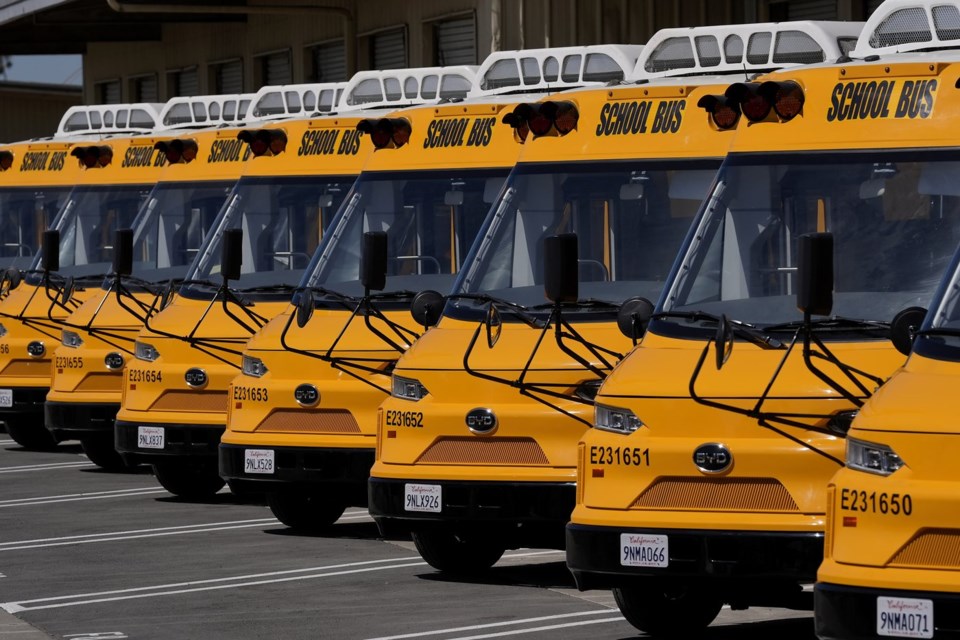BOSTON (AP) — Looking to cut pollution from its fleet of diesel-burning school buses, an Oklahoma school district last year doubled its electric vehicles.
The Shawnee Public Schools, a 3,300-student district about 35 miles (56 kilometers) east of Oklahoma City in a county that voted overwhelmingly for President Donald Trump, figured the nearly $1.5 million for the four buses would be reimbursed through an Environmental Protection Agency program. The agency, under President Joe Biden, had promised to do just that last year with money from a massive infrastructure law passed by Congress.
The district requested the funding in November but was told that it would be delayed due to a technical glitch. But after Trump took office, they have been calling the EPA and emailing regularly without a response. They fear they will never be reimbursed.
“Our district made this investment in good faith, expecting the promised rebate to be delivered in a timely manner,” John Wiles, the district's director of transportation, said. “The buses are here, they are in service, and they are benefiting our students and community — but the lack of reimbursement has created unnecessary financial strain.”
Districts nationwide wait for $1 billion
Shawnee is not alone. More than 500 districts nationwide are still waiting on around $1 billion from the EPA to cover more than 3,400 electric buses.
That's sparked panic and confusion in districts that must find other ways to cover the cost or delay or cancel their purchases. It's also hitting companies building the buses, those selling them and companies that oversee districts' transportation. The National School Transportation Association, which represents private school bus operators, called the freeze “extremely disruptive.”
The EPA hasn't explained why the funds are on hold or if they will ever be released. A spokesperson said the EPA does not comment on pending litigation. Multiple lawsuits have called for releasing federal funding frozen by myriad federal agencies including the EPA.
Sen. Ed Markey, D-Mass, one of several senators to write to EPA Administrator Lee Zeldin demanding answers, said the funding lets districts “invest in transportation that reduces air pollution and provides health benefits to children across the country.” Without the money, administrators may have to make tough financial decisions, “and children are going to pay the price,” he said.
The push for electric buses has long had bipartisan support, with many arguing the transition will help combat climate change, benefit the health of children and saves district money over the long run.
More than 25 million students take aging, diesel-fueled buses to school each day in the U.S. — with Black, Latino and lower-income students in urban areas more likely to rely on them.
The exhaust from these dirty buses exposes them, their parents and school staff to harmful pollutants like fine particulates and nitrogen dioxide, which can lead to health issues such as asthma and heart disease. It can also affect cognitive performance, said Dr. Stephanie Lovinsky-Desir, chief of the pediatric pulmonary division at Columbia University Medical Center. Young bodies that are still developing are especially vulnerable.
Advocates say electric buses save money
Electric school buses — though two to three times more expensive up front — can save districts money in fuel and maintenance costs, said Katherine Roboff, deputy director of external affairs for World Resources Institute's Electric School Bus Initiative. The WRI estimates $100,000 in savings over the life of a bus.
“That’s really helpful savings that school districts can put back into the classroom,” Roboff said. “And that’s another reason that districts are eager to go electric.”
The money is part of a Clean School Bus Program, which was part of Biden's infrastructure law and provided $5 billion over five years to help districts replace polluting school buses with cleaner, electric buses.
So far, the program has gone through three rounds. Nearly $1 billion was issued in the first round of rebate funding to 400 schools for 2,500 buses; the second round, issued in the form of grants also totaling nearly $1 billion, funded more than 2,700 school buses at 275 districts.
The long list of delays is hitting districts of all sizes, both rural and urban.
Charlotte-Mecklenburg Schools in Charlotte, North Carolina, the school district in Huntsville, Alabama as well as Baltimore County Public Schools, all of which contract with outside companies to run their transportation operations, are waiting for nearly $26 million to fund the purchase of 75 electric buses.
Prince George's County Public Schools, a 132,000-student district outside Washington, D.C., was expecting $5 million for nine electric buses to add to its current 21. When the EPA funding was put on hold, the district turned to the state of Maryland, which has a similar grant program, and is hoping it covers the cost.
In New Hampshire, the Derry Cooperative School District wasn't so fortunate. The 4,300-student district has been counting on $8.1 million in EPA funding to cover 25 electric buses.
“It's very disappointing,” Clifton Dancy, the district's transportation coordinator, said. “The current administration is turning a blind eye to climate change and environmental practices and catering to carbon fuel industry. I can't get behind that. It's going backwards.”
___
St. John reported from Detroit.
___
Read more of AP’s climate coverage at http://www.apnews.com/climate-and-environment.
___
The Associated Press’ climate and environmental coverage receives financial support from multiple private foundations. AP is solely responsible for all content. Find AP’s standards for working with philanthropies, a list of supporters and funded coverage areas at AP.org.
Michael Casey And Alexa St. John, The Associated Press




